PART 3

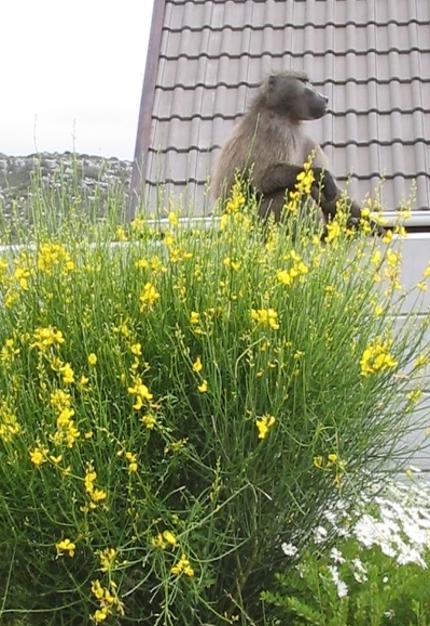

Before his death, William was classified by NCC, the current service provider, as the leader of a fission troop and a repeat raider - the controversial protocol of 2010 targeted both fission troops (the result of a male successfully dispersing) and repeat raiders.
The controversial "dispersing male" category of the 2009 protocol specifically targets male baboons. Sometimes, males leave the troop temporarily if fighting for dominance occurs in order to escape further injuries from sometimes fierce fighting.Yet, the protocol can be initiated by the baboon entering the urban area - not difficult as the Peninsula urban layout at times borders or cuts into their home ranges.
While some adult male baboons may stay with the troop, other male baboons can leave the troop a number of times during their lifetime. In other words, dispersal is a natural process that can be repeated a number of times during the animal's life - as in the case of William. Moving to another troop also prevents inbreeding.
In introducing the dispersing male protocol, the argument was made that males were no longer able to disperse to troops on the Peninsula but had to cross the Cape Flats in order to reach troops such as those in the Hottentots Holland area.
The argument was that because they were unable to cross the Flats with its sprawling urban area, males attempting to leave their troop would first be captured and eartagged as "dispersing males", taken back to their troop on second capture.
If they left the troop, on the third capture they would be taken to a different troop elsewhere on the Peninsula and given the "choice" of joining a new troop. If they did not "choose" to join the troop (or which is rather more accurately, they were chased away from the troop by its male baboons, protective of females and young), they could be culled. Culling was, however, an option even from the 2nd capture.
It should be noted that William, like other males have before and after him, succeeded in dispersing by himself in a natural process to nearby troops on the Peninsula, without human intervention.
To illustrate, William moved - by himself, without human intervention - from his natal Da Gama Park troop to Kommetjie, then to Scarborough.
The argument of males wanting to cross the Cape Flats was used in support of the dispersing male protocol by saying that the means of natural dispersal to other troops currently is not available and therefore human intervention is required to return the baboon to its own troop in the 2nd capture, in the 3rd capture to take the baboon to another troop deemed by officials to have a "vacancy" - often far from his own troop, leaving him isolated and vulnerable if not accepted into the troop and likely to pass through the urban area should he attempt to return to his troop.
The 3rd capture of the protocol allows for a tagged male to be physically taken to another troop in the Peninsula, supposedly offering it another opportunity before culling. However, the chances of it being accepted when taken to a new troop and expected to "choose" to join this new troop, as was stated, are small and will no doubt involve further fighting especially if there are only one or two males in the existing troop who will fight fiercely to defend against an intruder. The fighting also poses possible negative effects for the existing troop members, including females and young, from the "intruder".
Should he succeed in taking over, the possibility of infanticide exists - killing of the young. This brings lactating females into the reproductive cycle again, allowing the new male to sire his own offspring.
If the baboon is not accepted into the new troop, for instance when taken from Tokai to Cape Point, he will be isolated, and given the layout of the Peninsula, if he attempts to find his way back to his natal troop, will more than likely come into contact with the urban area again.
Tagged dispersing males, including Bart, Sol and Anele were taken to other troops but were predictably not accepted, given that in nature dispersal is a gradual process involving exploratory expeditions, with the male often establishing a relationship with one or two females on the periphery of the troop that can help facilitate acceptance into the troop.
Ear tagged male Sol was brought to the Simonstown area, did not integrate into a troop and was culled in terms of the first dispersing male protocol of 2009. (A young male Clint was taken from the northern troops Tokai area to the Plateau Road area in April 2011 but was not accepted there and again began moving northwards. In August 2011 he was still not accepted into a troop, taken to the Da Gama Park troop but chased away by the alpha male.)
An increasing number of adult baboons are eartagged or collared. In April 2011, other baboons including females were tagged, ostensibly to study possible transmission of pathogens between baboons and humans. (Potential transmission of disease was given as a reason for motivating culling Bart, the first baboon targeted by the first protocol.)
Members of the public have often found it difficult to obtain information about the baboons regarding their status including current numbers and deaths of baboons or data regarding relocation attempts claimed to be a pioneering success. In the light of culling protocols, secrecy or lack of transparency regarding the baboons is not conducive to creating an impression that the best interests of the baboons are being considered or that public participation by concerned residents is welcomed. Residents are told to contact their BLG representative who may not have access to the information or be able or permitted to part with it.
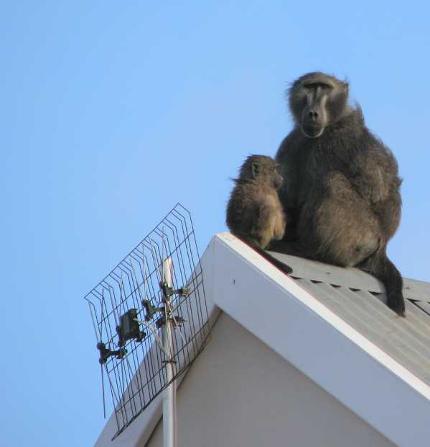

Baboons on roof in residential area.
The protocols are considered to be biased against natural baboon behaviour and circumstances. Additionally, of concern is that in effect they attempt to override their legally protected status by reducing them to the status of raiders, problem or damage causing animals - as they are in the rest of the country where they are killed with impunity.
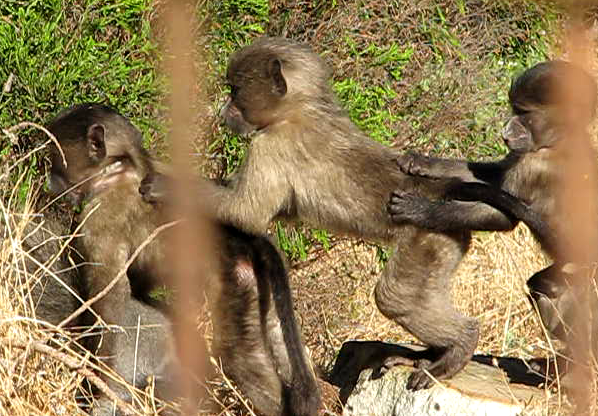
Standing behind a fence, three young babooons show their own version of "holding the line" using an actual visible "barrier" with no gaps. Holding the line, however, as has been implemented is an "imaginary barrier" baboons were supposed to respect and not cross, failed to work in keeping baboons out of residential areas especially when held next to or even in the urban area as in Da Gama Park.
The new service provider, NCC implemented "holding the line" a method whereby 3 or 4 monitors, often handling a troop of around 30, maintain a "virtual barrier", an "imaginary barrier" and attempt to prevent the baboons from getting past them. In many instances this fails to work, as baboons simply break through the gaps and go towards the nearby urban area where they are able to raid unsecured properties. Once one baboon manages to break through and a monitor goes off to fetch it, the line further disintegrates.
The monitoring programme as run by Baboon Matters focused on herding the baboons to forage in the hills, away from human settlements, to reduce conflict. The budget for NCC was increased substantially and while the new service provider doubled the number of monitors to around 60, because many were either not trained in or sufficiently encouraged to use the humane and effective method of whistles, shouts and baboon-vocalisation the baboons were already accustomed to, it did result in inability to move the baboons out as quickly if in the urban area and increased residents' frustration at raids of unsecured bins and properties.
Though increasingly sidelined in working with the baboons, including transporting injured baboons to the vet, Baboon Matters continued to receive calls from residents. When humane methods are still used by monitors trained by Baboon Matters - despite the opinion of detractors of these methods which includes the research unit in public lectures and in the media - they still work.
In using the holding the line method, instead of moving the baboons out the area, they were also kept closer to residential areas than they should be.

A monitor picks up a overly large branch from the ground in an attempt to assert dominance over George, the aging former alpha male baboon (circled).
Monitors need proper training in how to handle and deal with the animals in an assertive manner when required rather than either a passive or aggressive one. Monitors who are scared of the baboons are unable to show the necessary assertive approach in a monitoring situation when dealing with the males. In lieu of proper training, they may instead resort to aggressive means to try and control the baboons such as throwing stones or sticks at them, as residents have witnessed. Over the past two years field staff have expressed willingness to receive training from Baboon Matters.
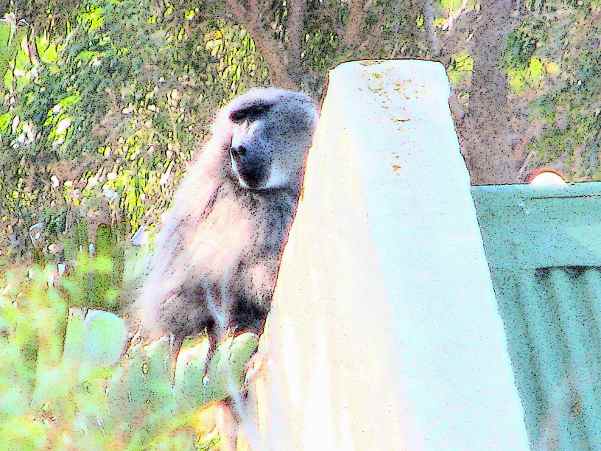
Adult male baboon on rooftop. This male at times may leave the troop when there is fighting but returns to it once tensions subside. Yet the protocol allows baboons to be removed from the troop and taken to another or culled if leaving the troop and coming into the urban area, often difficult to avoid given the Peninsula layout.
While female baboons may stay with the troop for their lifetime - unless they leave with a male to start a fission troop - male baboons can leave the troop more than once during their lifetime as well as leaving it temporarily if fighting. In nature, dispersal is often a lengthy process, something the protocol seeks to expedite.
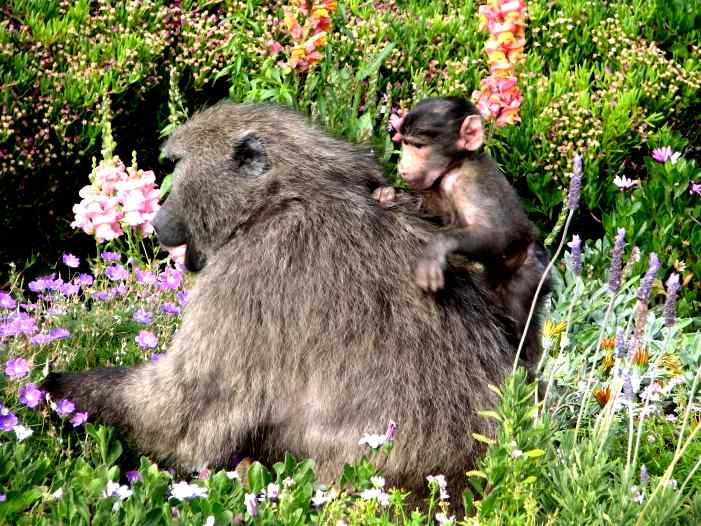
Female and baby amidst the spring flowers on a residential pavement. Flawed arguments have been used by some that "protecting the species" is more important than safeguarding the individual Peninsula baboon or that the culling protocol is justified as baboons have no "natural enemies."
These are irrelevant arguments as the Peninsula baboons showed little change from around 350 during the last decade therefore individuals are important to preserve the remaining indigenous Peninsula baboons that have been there since before the Cape was settled. Man and dogs certainly qualify as "enemies" causing injury and loss of life.
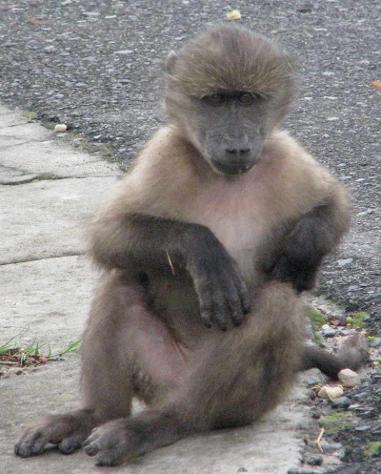

Much of the troop is made up of youngsters like this and females, much smaller than males.
Baboons are sensitive and can be easily stressed, another
reason why the attempted introduction or use of bull whips and bear bangers is seen as contrary to the baboons' best
interests while also being entirely unnecessary, apart from the fact that they can potentially cause injury, even accidentally, and also send a wrong message to residents already hurting baboons. Paintballs have also been used.


While balancing on a branch, one female attempts to examine the baby of another. Babies are born with black fur and pink faces and while small are of intense interest to other troop members, particularly other females, and are often pulled and prodded in order to examine them.
Given the males' protective role, people should avoid getting too close or attempting to touch the young, even though seen as "cute". If a baby squeals, the males' instinctive reaction is to rush to its defense. This is especially important for tourists who see baboons for the first time along the roadsides and think they may be petted or fed. Baboons remain wild animals and must be treated with respect.

Adult male baboon, Sebastian, in tree. Some are under the mistaken impression that hurting or frightening the baboons can deter raids. Effective baboon-proofing is the solution to raids. Though some troop members may be hurt or killed, the attraction of food outweighs the risks for the other troop members. Many of the baboons are riddled with pellets or even have bullets lodged in their bodies.
A misconception about preventing raids is that the fear of man must be re-introduced and that baboons are too used to people - a view put forward by the current service provider in a syndicated article as a reason for using whips. Raids are prevented by baboon-proofing with well trained monitors minimising the time baboons spend in urban areas.
(Attempting to establish a distance between people and baboons was the first indication that Baboon Matters' walks would be cancelled (which subsequentlly occurred in early 2011 when permission was refused for conducting walks on SANParks land.) It should be noted that numerous international researchers have had extremely close contact with the baboons in the past. As a changing stream of baboon researchers approach baboons very closely, this reason for introducing whips and bear bangers seems implausible. Additionally, monitors continue to come close to baboons in the course of doing their work.)
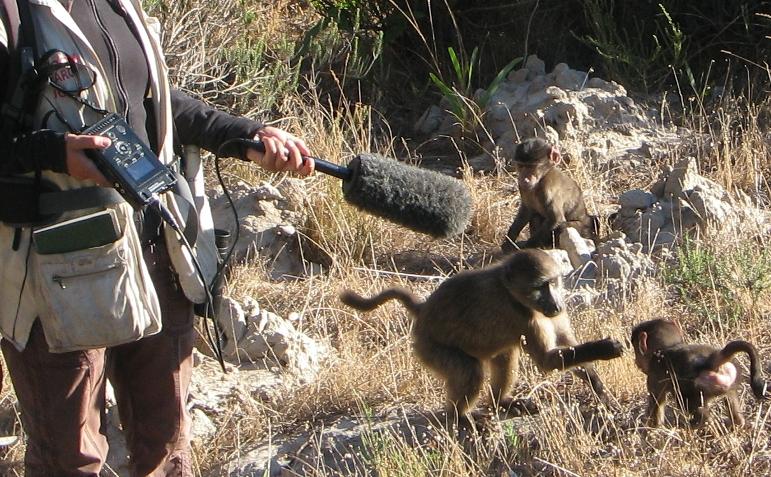
Baboon researcher studying baboon vocalizations. Apart from a regular stream of scientific researchers studying their behaviour, given that humans and baboons come into contact, for example, along Simonstown to Cape Point when tourists stop their vehicles to admire the view, or baboons' home ranges border or intersect the urban areas, baboons do see humans on a regular basis and therefore are to an extent habituated to humans.
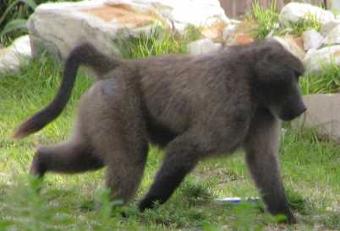

Adult male baboons. In areas towards Cape Point there have been warning signs for
decades not to feed baboons, often unheeded though management of the Reserve also has a responsibility not to allow the display of food in areas such as parking lots or take-away restaurants, which can precipitate food grabs.
Feeding baboons endangers baboons' lives as they can be culled if deemed "repeat raiders" or if they are seen as "aggressive" by authorities in their attempts to obtain food.
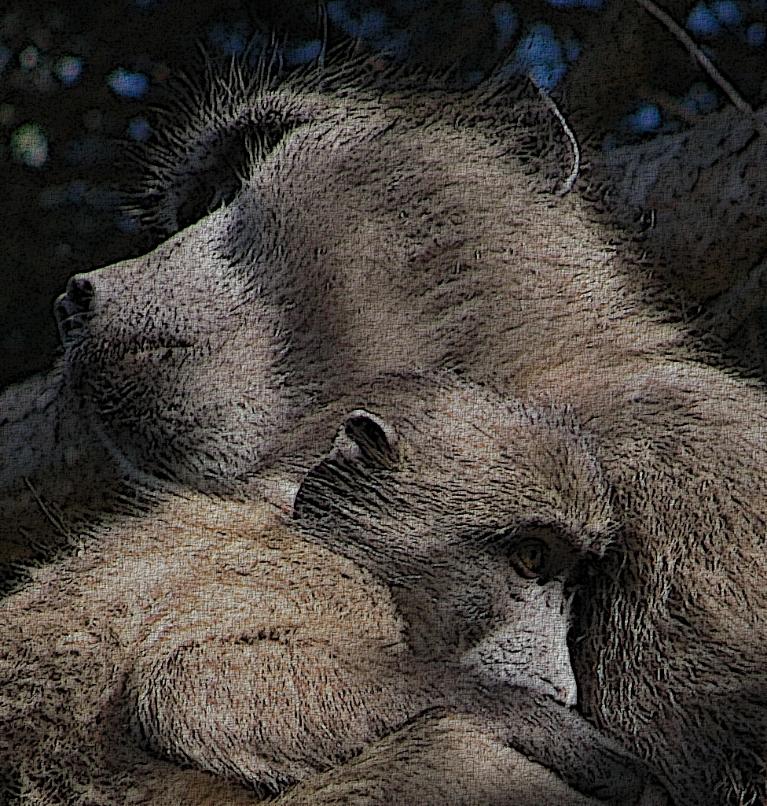
Young baboon sits close to a female baboon. It shows signs of trauma after the introduction of bullwhips, one of the recommendations earlier made in a presentation by the head of a baboon research unit at a baboon expert workshop in July 2009, following a trial of bull whips and bear bangers by a group of Simonstown residents in June acting in conjunction with the unit. Their implementation in other troops by the interim service provider, not long after taking over from Baboon Matters, raised a public outcry and objections from the SPCA in September 2009. They have attempted to use them during the past two years despite objections.
On the first day bull whips were introduced to a troop, an eyewitness observed a monitor allegedly lash out towards the adult male's face, causing him to flee up a roof and not come down. Days after the incident, the youngsters were heard on different occasions emitting an alarm cry when someone came into sight.
Horsewhips and bullwhips continued to be used for the Simonstown Smitswinkel troop. The Civic Association in that area stated they wanted baboons totally removed from the urban area and would pressurize authorities for this.
Contrary to SPCA warnings, bullwhips were attempted to be re-introduced again by NCC, the new service provider in May 2010, using the argument that baboons have lost their fear of man which must be restored.
In December 2010 Dr O'Riain of BRU again argued for the use of bearbangers in a newspaper article. The city vet was quoted in a January newspaper article as having given approval for them and in another article in July 2011 again urged their use (they had been used in the Smitswinkel troop in the months before Fred's culling in March and in May and in June 2011 NCC proposed their use in Scarborough.) On 11 October, she also stated that paintballs would be used where residents gave their approval, shortly thereafter paintballs were seen used in the Constantia area.
Some believe using whips and aggressive "tools" is more in line with baboon-baiting, others that there is the potential for baboons to be injured or that the whips used in a threatening manner that could provoke either negative or defensive attitudes, that could be construed as aggression and then lead to the baboons coming under consideration for culling and that the humane approach used by Baboon Matters with well-trained monitors using assertive whistles, baboon sounds and shouts should be used again consistently with all troops.
While an assertive manner is needed in managing the troop, aggression or bewildering the animals should be avoided. This places the baboons in a position of not being able to trust their caregivers and could lead to negative behavioural changes. Without proper training or being encouraged to follow effective methods, monitors are also being placed in a difficult situation with regard to being able to do their jobs properly.
If monitors are scared of the baboons due to lack of training or understanding of baboons or if baboons are either intimidated or provoked to an "aggressive" response as a defense response, there is a need for immediate training by acknowledged experts in the field such as Baboon Matters in order not to risk failure in what was previously acknowledged as an effective method of keeping baboon-human conflict to a minimum.
(As a result of the Baboon Management Team being disbanded, (with resignations of members like Baboons Matters and SPCA due to objections to management strategies and processes), the BLG, which includes civic representatives from Simonstown and Scarborough and other baboon affected areas came into being. The Baboon research unit, BRU, is a founding member. Both share a long-term goal of baboons never entering residential areas. However, given the Peninsula layout and current baboon home ranges, this is seen by others as an unrealistic goal and is not shared by all residents.)
A so-called "vision" of removal of baboons from urban areas (using "tools") as presented at a meeting in Da Gama Park in October was not previous City policy but rather that of BRU presented in 2009 at the baboon expert workshop in a presentation that included "selective removal" or culling of baboons.

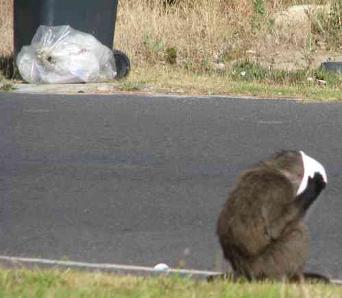
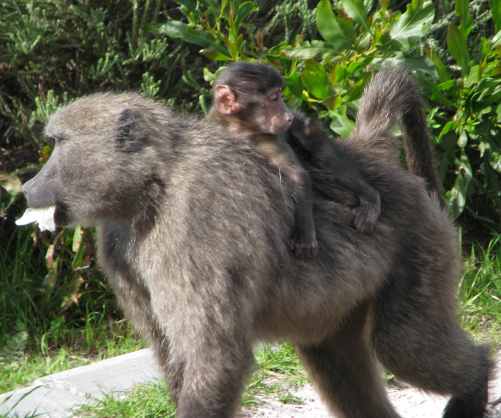
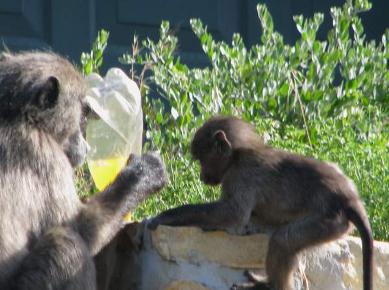


Young baboons and female eat food from unsecured properties. These scenes could have been easily prevented by effective baboon-proofing. Rather than raiding being confined to male baboons as per the original August 2009 "action plan for dispersing males and repeat raiders", baboons of any age and sex will raid given the opportunity - as illustrated above.
In defining baboons as "repeat raiders" i.e. problem or damage-causing animals, the repeat raider clause of the protocols attempts to override the baboons' protected status. It should be noted that residents who consistently effectively baboon-proof do not experience raids.
Many believe the scientifically flawed and biased protocols need to be revoked as they endanger the Peninsula's small baboon population that has shown little change over a decade.
The 18 June 2010 protocol not only focuses on individual raiders but also on other categories of baboons, including fission troops. While it has been claimed the protocol has mitigating factors, it was pointed out that these were not taken into consideration for the first baboon killed in terms of the 2010 protocol, William and there were concerns they would again be ignored in future.
While residents also regarded William as an alpha male, a mitigating circumstance against culling, he was described by the service provider as part of a fission troop (one of the categories for removal according to the 2009 BRU presentation.)
In March 2011 Fred of the Smitswinkel troop was culled allegedly for opening car doors with people in the vehicles and for aggression, with officials claiming at the time that he was not the alpha, although this was disputed by those who had regular contact with the troop. The ITV series "Baboons with Bill Bailey" made shortly before Fred was culled consistently referred to him as the alpha male, including in a tribute after his death.
It had been stated at the time of his culling by some officials that, Jimmy, a baboon originally from the Waterfall troop would be given a chance to be alpha. He did not stay with the troop, complaints were made about him raiding and he was culled in July along with another dispersing male Oswald (TK8) from the Tokai troop. When new management became involved, including the scientific research unit, the baboons were assigned numbers. Names are currently being phased out.
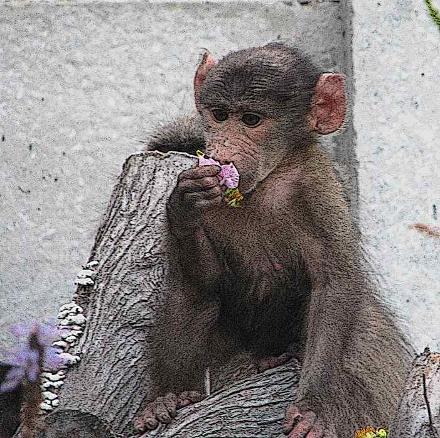
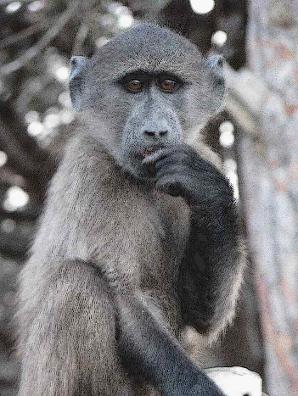
Baby smells a flower and a juvenile eats a pine nut. The future of the Cape Peninsula's Chacma baboons has seemed increasingly threatened over the past two years since changes in management and strategies.
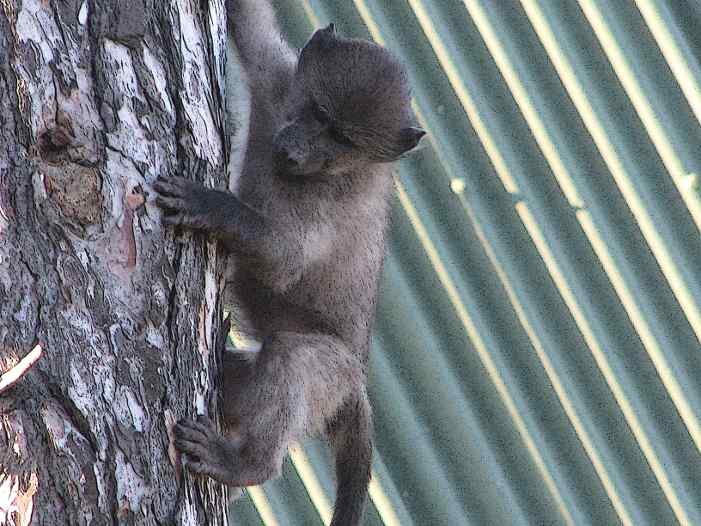
Young baboon climbs tree in a residential area. Baboons are able to easily scale double or triple storey buildings and sit on residents' roofs. Young baboons enjoy sliding down the roofs. While some residents complain they dislodge gutters from their brackets, this is remedied by using stronger brackets or dispensing with gutters altogether.
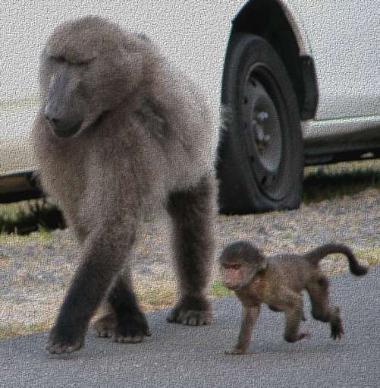
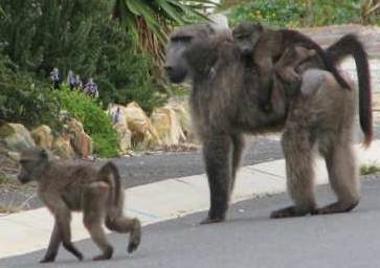
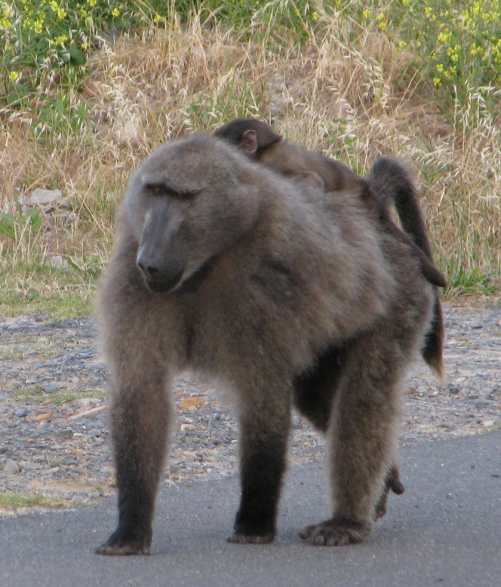
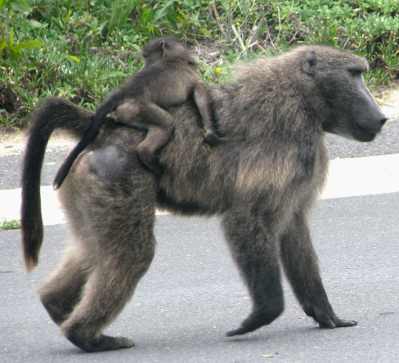
Adult male with baby on back in road with youngsters. While in the road, baboons may be ridden over by vehicles, either deliberately or through negligence. Each year a number are killed in this way.
One of the reasons the protocol
is biased against the baboons is
that home range and urban area may be separated by only a street or the
urban area actually cuts into the home range.
The protocols are unfairly biased in culling baboons for raiding as has occurred, especially when some residents refuse to baboon-proof, claiming they do not want to live like "prisoners" or that it is "inconvenient" though other residents find by taking consistent effective measures, they can successfully prevent raids.
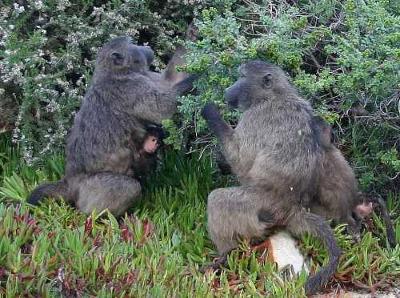
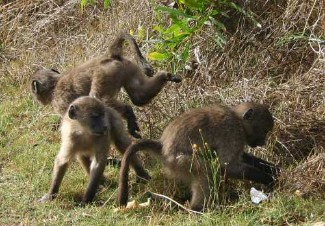
Females with young forage in residential area and three young baboons in a residential area. Females give birth to a single baby and gestation is six months. Young baboons are weaned at around a year.
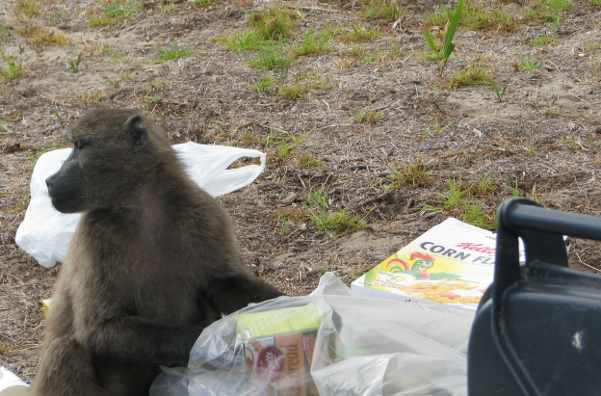

Young baboon sits between two sleeping baboons.
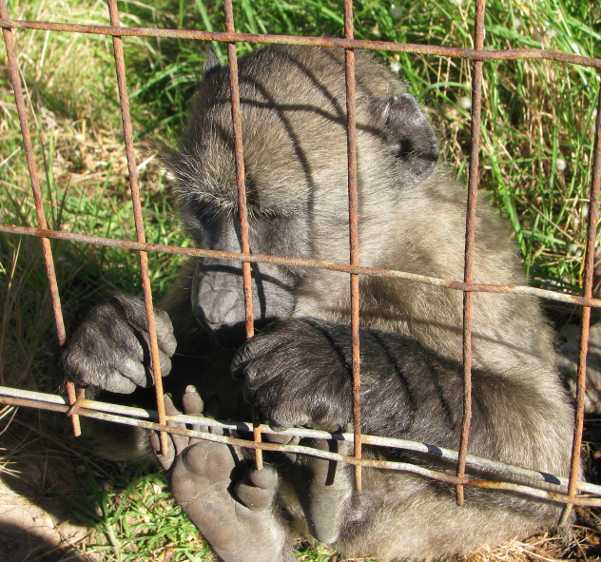
Juvenile baboon holds onto fence. While some residents opposing baboons in the urban area would prefer they were either culled or removed elsewhere, others are concerned that given protocols that target baboons for coming into the urban area, and the 2009 proposals advocating a reduction of numbers, if culling continues for various reasons including raiding and dispersing males, it could have knock on effects on troop viability. Baboons are now also being sterilised. In November 2011, the local newspaper, the People's Post quoted the head of BRU saying that "BRU will make recommendations to implement contraception methods" in the Da Gama Park troop. The same day one of the two males of the small fission troop was castrated.
To allay concerns of the public, there is a need for transparency. Aside from the culling protocol not being made available, the public's questions, even on factual issues have frequently been ignored, including denial that a baboon is in the process of being trapped for culling.
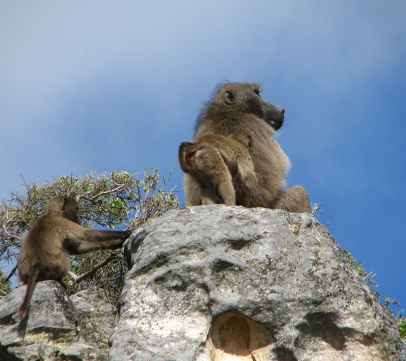
Male sits on rock with two youngsters. In nature, the Chacma baboon troop structure has a number of adult males in the hierarchical structure headed by the alpha male.
Following the introduction of the protocol in August 2009, a baboon management tender operational from 1 February 2010 - 30 June asked for quotes to remove, relocate and/or euthanize a quantity of "dispersing males" per month, as did one for a long term contract which affirmed to any in doubt, as some were, that culling was part of the new management strategy. This was confirmed when Sol was killed in January 2010 in terms of the first protocol for dispersing males and repeat raiders and William was killed in terms of the second individual raiders protocol on 2 July 2010 followed by Fred in March 2011 and Jimmy and TK8 in July 2011.
After the first culling protocol was introduced, some of the males such as Bart, the first baboon targeted by the protocol, were made offers of translocation, including by a wildlife reserve that has troops of baboons.
Translocation to areas outside the Peninsula is currently not an option currently according to the Wildlife Advisory Committee (WAC) of CapeNature. It should be noted that some of the same precautions such as disruptions to the receiving troop apply against introducing a baboon to a new troop on the Peninsula, yet this is allowed in capture 3 of the protocol.
WAC has no actual contact with the baboons but makes the final decision on which baboons are to be culled after considering recommendations from the service provider, researchers, as well as residents' complaints.
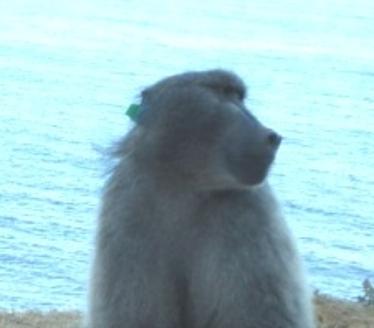
Photos of Fred and Jimmy supplied All rights reserved

Fred of the Smitswinkel troop with green eartag and Jimmy (with collar and tag) not long before each was culled. When Fred was culled (March 25 2011) officials stated Jimmy of the Waterfall troop was being given a chance to become alpha of Smitswinkel. This did not occur and Jimmy was culled on 15 July. GPS and VHS tracking collars determine baboon location and give a record of their raiding habits that can be used as evidence when under consideration for culling.
Since 2009, males have been eartagged in the first step in the dispersing male and repeat raider protocol, which some have viewed as a means of being able to cull any baboon deemed to be a problem, particularly if seen as "aggressive".
This puts this small Peninsula population at risk of having their numbers begin to dwindle, given that baboons are also regularly killed as a result of human interaction.
In 2011, other baboons, including females, have also been eartagged for BRU's research attempts to establish transmission of diseases between humans and baboons.
There is concern amongst some that methods and strategies currently used involve too much experimentation, including monitoring methods and scientific research on the free-ranging population, and that the focus needs to once more shift to the conservation of the baboons.
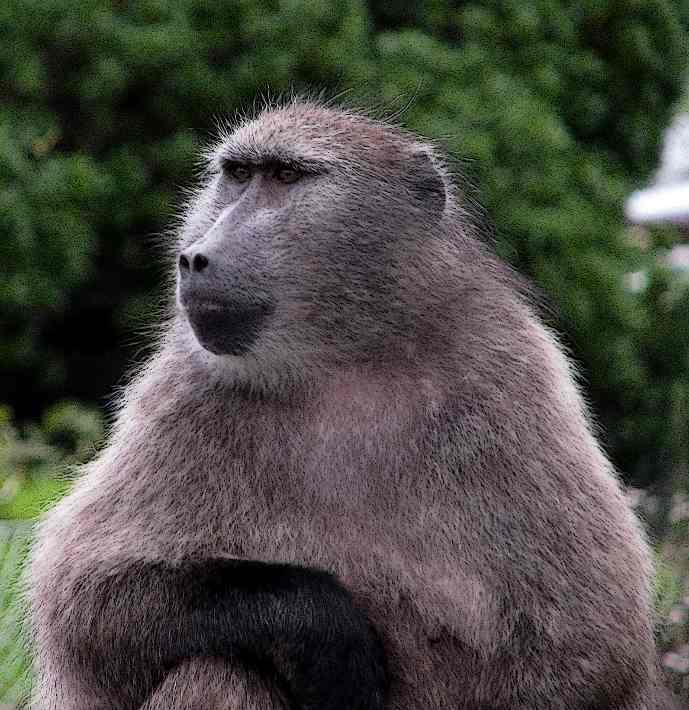
This
female
baboon, like many surviving
baboons in the Cape Peninsula, may be peppered with pellets,
bullets and birdshot from irate or intolerant residents.
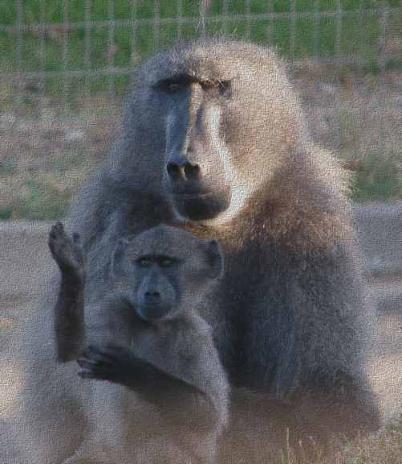
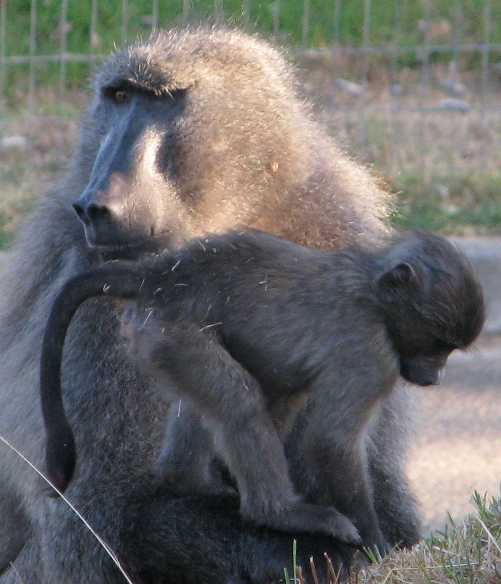
Male baboon {Quizzy} sits with youngster. While male baboons are, often unjustifiably, given a very bad press, usually due to the fact that they have long canines that people see as a threat or to movie or media sensationalism, it is their close and caring relationship with the young that changes many people's attitudes to them.
All Content by site author Copyright 2009-2011
All Rights reserved L Thomas
No portion of content may be reproduced in any way without written permission
Individual Rights apply to FLICKR photos